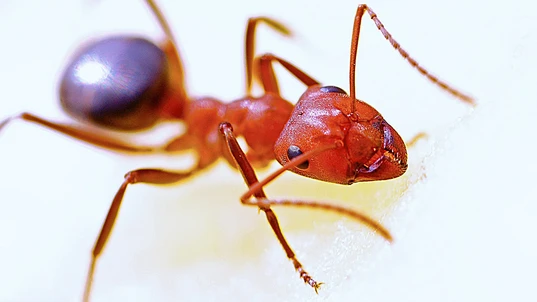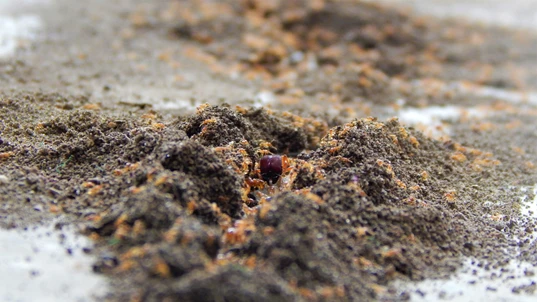Fire ants: What to do when stung?

Bites and Stings

Found throughout south east Queensland, Fire ants are renowned for their aggressive nature and painful sting. They are particularly dangerous to those with allergies, as they tend to swarm and sting all at once.
Found in large swathes across South East Queensland, fire ants (Solenopsis invicta) are an exotic ant species that are renowned for their painful sting and aggressive nature. They are considered one of the worst invasive species to reach Australian shores. Not only do they represent a threat to public health, but also to the environment, the economy, and every day living. For this reason, there is a National Fire Ant Eradication Program underway to find, contain, and destroy their incursions in South East Queensland. Continue reading for more information on the Fire ant, what to do if you are bitten by one, and how to reduce the risk of Fire ant infestations in your home and local community. We also cover insect bites in the following first aid courses: You can head to our Locations page to enrol in a course near you.Appearance
Fire ants, otherwise known as Red imported fire ants, have the following identifying characteristics:- 2 - 6 mm long, with each nest comprising a variety of sizes
- Copper- or reddish-brown in colour with a darker brown-black abdomen
- Their waist section has 2 segments
Distribution
Fire ants are native to the South American countries of Argentina, Brazil, Paraguay, and Uruguay. They were accidentally introduced into Alabama in the 1930s, and due to their highly adaptive nature, they have become pests in:- America
- China
- Japan
- Taiwan
- The Philippines

Fire ants tend to build their nests in large expanses of greenspace, including parks, school yards, and golf courses. While their nests sometimes look like dome shaped mounds of dirt, they can also look like mere patches of disturbed soil.
Habitat
Fire ants tend to build their nests in sunny open areas, such as lawns, parks, roadsides, golf courses, and school yards. They have also been found in rotten logs, building walls, and along pavers. Their nests can look like dome shaped mounds of dirt or simply flat patches of disturbed soil. When built into mounds, Fire ant nests can be as high as 40 cm. The ants enter and leave their nests via a myriad of underground tunnels that radiate outwards and can be up to 30cm long. As such, there are no visible entry or exit holes.Danger to humans
Fire ants are considered dangerous to humans, as they have a painful sting that can cause swelling, redness, and a long-lasting burning or itching sensation. Their stings can also develop small blisters or pustules a few hours or days after the fact, which can become itchy and cause infection if scratched repeatedly. Likewise, Fire ant stings are particularly dangerous to those with allergies, as:- Fire ants communicate with one another through stridulation and chemical secretion, and they swarm and sting all at once when their nest is disturbed
- They have strong mandibles and can hang on to their victim while stinging repeatedly
- Contrary to other insect stings, Fire ant venom builds up in the body
- Hives
- Facial swelling
- Rapid pulse
- Breathing difficulties
- Collapse
Other impacts
As well as being dangerous to human health, Fire ants represent a major risk to the health of our environment, economy, and everyday living. For instance:- They can swarm the faces of pets and livestock that are exploring their surroundings nose-first, which can subsequently cause blindness and suffocation
- They feed on native fauna that nest or forage on the ground, including insects, reptiles, amphibians, and mammals
- They feed on and damage native seeds, as well as predate or disturb insects and animals that help pollinate native plants
- As they tend to build their nests in larges expanses of greenspace, Fire ants can disrupt the usability of sport and recreation areas
- They can destroy irrigation and harvesting equipment, as well as agricultural and horticultural crops, which can increase costs to agricultural businesses
First aid for a Fire ant sting
- Move the casualty and others away from the fire ants
- Calm and reassure the casualty
- Apply a cold compress to the affected area to reduce pain and swelling
- Gently wash the affected area with soap and water
- Leave the blisters intact
- Monitor for signs of an allergic reaction
- Report the incident to the authorities and ensure the area is closed off to reduce the chances of future stings
Final thoughts
Fire ants are an invasive ant species found throughout south east Queensland. These highly adaptative critters have an aggressive temperament and a painful sting, and so represent an enormous threat to Australia's health, economy, and environment. Fire ants have been known to build their nests in open, grassy areas and sometimes under timber, logs, rocks, pavers, or bricks. If you suspect a Fire ant-infested area, contact the National Fire Ant Eradication Program. And to learn more about identifying and treating insect stings, book a general first aid course or a child care first aid course at a Location near you today.
Originally published at
https://www.australiawidefirstaid.com.au/resources/fire-ants
as part of the Australia Wide First Aid Articles Library









